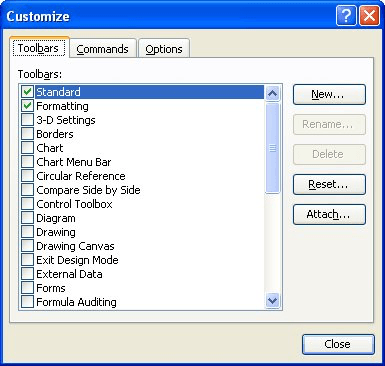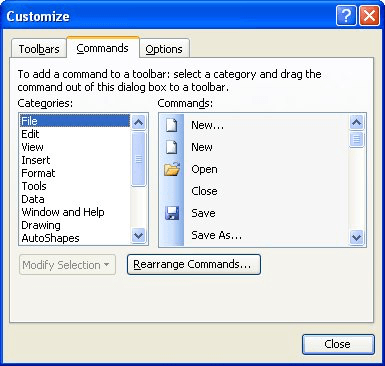Written by Allen Wyatt (last updated October 2, 2021)
This tip applies to Excel 97, 2000, 2002, and 2003
Excel is a very flexible program. You can configure it to work just about any way you can imagine. For instance, you can create a macro, and then add it to a toolbar. To do this, follow these steps:

Figure 1. The Toolbars tab of the Customize dialog box.

Figure 2. The Commands tab of the Customize dialog box.
Note:
ExcelTips is your source for cost-effective Microsoft Excel training. This tip (2926) applies to Microsoft Excel 97, 2000, 2002, and 2003.

Create Custom Apps with VBA! Discover how to extend the capabilities of Office 365 applications with VBA programming. Written in clear terms and understandable language, the book includes systematic tutorials and contains both intermediate and advanced content for experienced VB developers. Designed to be comprehensive, the book addresses not just one Office application, but the entire Office suite. Check out Mastering VBA for Microsoft Office 365 today!
When you record a macro, make sure that you know how Excel is recording your cell movements. This tip explains the ...
Discover MoreWant to get some input from the users of your workbooks? You can do it by using the InputBox function in a macro.
Discover MoreYou can create macros that run whenever Excel detects a certain event happening within an entire workbook. This tip ...
Discover MoreFREE SERVICE: Get tips like this every week in ExcelTips, a free productivity newsletter. Enter your address and click "Subscribe."
There are currently no comments for this tip. (Be the first to leave your comment—just use the simple form above!)
Got a version of Excel that uses the menu interface (Excel 97, Excel 2000, Excel 2002, or Excel 2003)? This site is for you! If you use a later version of Excel, visit our ExcelTips site focusing on the ribbon interface.
FREE SERVICE: Get tips like this every week in ExcelTips, a free productivity newsletter. Enter your address and click "Subscribe."
Copyright © 2025 Sharon Parq Associates, Inc.
Comments